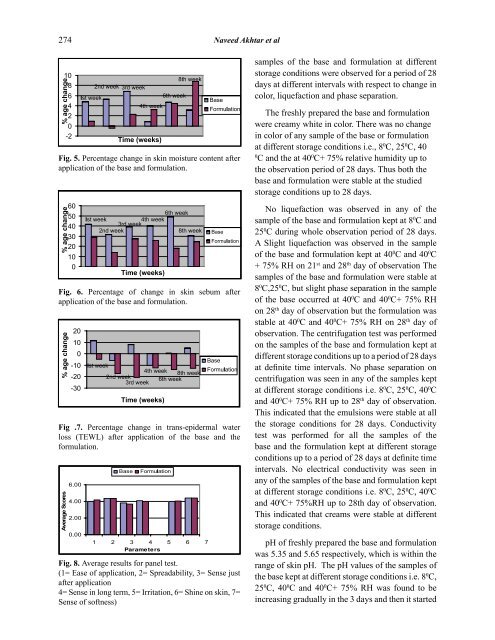Download Full Journal - Pakistan Academy of Sciences
Download Full Journal - Pakistan Academy of Sciences
Download Full Journal - Pakistan Academy of Sciences
Create successful ePaper yourself
Turn your PDF publications into a flip-book with our unique Google optimized e-Paper software.
274 Naveed Akhtar et al<br />
samples <strong>of</strong> the base and formulation at different<br />
storage conditions were observed for a period <strong>of</strong> 28<br />
days at different intervals with respect to change in<br />
color, liquefaction and phase separation.<br />
Fig. 5. Percentage change in skin moisture content after<br />
application <strong>of</strong> the base and formulation.<br />
Fig. 6. Percentage <strong>of</strong> change in skin sebum after<br />
application <strong>of</strong> the base and formulation.<br />
Fig .7. Percentage change in trans-epidermal water<br />
loss (TEWL) after application <strong>of</strong> the base and the<br />
formulation.<br />
Fig. 8. Average results for panel test.<br />
(1= Ease <strong>of</strong> application, 2= Spreadability, 3= Sense just<br />
after application<br />
4= Sense in long term, 5= Irritation, 6= Shine on skin, 7=<br />
Sense <strong>of</strong> s<strong>of</strong>tness)<br />
The freshly prepared the base and formulation<br />
were creamy white in color. There was no change<br />
in color <strong>of</strong> any sample <strong>of</strong> the base or formulation<br />
at different storage conditions i.e., 8 0 C, 25 0 C, 40<br />
0<br />
C and the at 40 0 <br />
the observation period <strong>of</strong> 28 days. Thus both the<br />
base and formulation were stable at the studied<br />
storage conditions up to 28 days.<br />
No liquefaction was observed in any <strong>of</strong> the<br />
sample <strong>of</strong> the base and formulation kept at 8 0 C and<br />
25 0 C during whole observation period <strong>of</strong> 28 days.<br />
A Slight liquefaction was observed in the sample<br />
<strong>of</strong> the base and formulation kept at 40 0 C and 40 0 C<br />
st and 28 th day <strong>of</strong> observation The<br />
samples <strong>of</strong> the base and formulation were stable at<br />
8 0 C,25 0 C, but slight phase separation in the sample<br />
<strong>of</strong> the base occurred at 40 0 C and 40 0 <br />
on 28 th day <strong>of</strong> observation but the formulation was<br />
stable at 40 0 C and 40 0 th day <strong>of</strong><br />
observation. The centrifugation test was performed<br />
on the samples <strong>of</strong> the base and formulation kept at<br />
different storage conditions up to a period <strong>of</strong> 28 days<br />
<br />
centrifugation was seen in any <strong>of</strong> the samples kept<br />
at different storage conditions i.e. 8 0 C, 25 0 C, 40 0 C<br />
and 40 0 th day <strong>of</strong> observation.<br />
This indicated that the emulsions were stable at all<br />
the storage conditions for 28 days. Conductivity<br />
test was performed for all the samples <strong>of</strong> the<br />
base and the formulation kept at different storage<br />
<br />
intervals. No electrical conductivity was seen in<br />
any <strong>of</strong> the samples <strong>of</strong> the base and formulation kept<br />
at different storage conditions i.e. 8 0 C, 25 0 C, 40 0 C<br />
and 40 0 <br />
This indicated that creams were stable at different<br />
storage conditions.<br />
pH <strong>of</strong> freshly prepared the base and formulation<br />
was 5.35 and 5.65 respectively, which is within the<br />
range <strong>of</strong> skin pH. The pH values <strong>of</strong> the samples <strong>of</strong><br />
the base kept at different storage conditions i.e. 8 0 C,<br />
25 0 C, 40 0 C and 40 0 <br />
increasing gradually in the 3 days and then it started

















